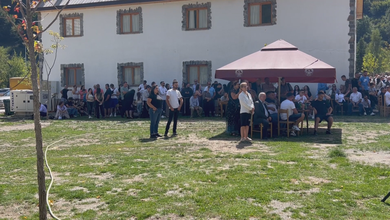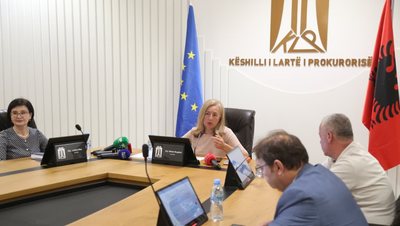
In an Albania where every corner of Instagram lights up with the LED lights of the latest “haul” or the filter of a “perfect” day, influencers have taken on a status that was once reserved only for classic VIPs. With a phone in hand and an audience built on an algorithm, they have become economic engines that generate significant income, now also under the surveillance of the Tax Administration…
On Albanian social networks, every morning begins with a "story." A coffee in the morning light, an "unboxing," a sweet-voiced greeting for followers, a collaboration coded as sincere love for a new product.
On the surface, this is a modern ritual, a daily, intimate, and harmless form of communication. But behind this minimalist narrative lies a much larger financial reality than meets the eye: a shadow economy that operates through views, likes, and an audience that converts into tangible income.
In Albania, where the majority of young people are active users of social networks and where the digital advertising market has grown by over 25 percent each year since the pandemic, the influencer phenomenon is no longer a minority trend, but a central part of how everything from face cream to self-esteem is consumed, advertised, and sold.
And yes, even "mind" is for sale! And yet, for years, this income has not been included in the state's fiscal logic, creating a dangerous vacuum: on the one hand, we have citizens who earn tens of thousands of euros a year; on the other, a state that until yesterday didn't even know where to look for it.
In the announcement a few months ago by the General Directorate of Taxes, based on verifications with banks, it was stated that over 33 million euros were generated by individuals through digital platforms such as Meta, Facebook, YouTube, Google, etc.
The figure is official, but it does not actually represent the entire market; it is just the tip of an iceberg of immeasurable revenues, which, due to the decentralized and informal nature of the sector, are neither documented nor controlled.
This reality is changing. For the first time, individuals who generate income from social platforms are invited to declare their earnings on the annual DIVA 2024 form.
And if for most freelance professionals, this date was expected and accepted, for many influencers it represented an existential dilemma: to admit that they are businesses and enter the system, or to continue to remain in the shadow of fame, without accountability and responsibility.
Aneid Kaloti, founder of the “SHET Industry” platform, which closely follows the developments of creative markets, states that currently, management is done by genuine agencies, but the total formalization of the market is a matter of time. “We are witnessing a new economic reality that is challenging the traditional model of entrepreneurship.
"When the income of a girl who publishes a 'morning routine' video exceeds the income of a small business that pays rent, insurance and taxes, the state can no longer turn a blind eye. The same logic should apply to everyone: if you earn, contribute," he says.
Influencers have become the most powerful engines of commercial and often cultural communication. They influence purchasing decisions, the values that are promoted, the way young people see themselves, success, bodies, fashion, and identity.
And they exert this influence without any institutional oversight, without training in social responsibility, without mandatory ethics. They are an alternative media with massive influence, but without an accountability structure.
Tomi Kallanxhi, founder of “Big Media Expert”, articulates this gap more directly: “In any serious market, influencers are not simply people with many followers, they are commercial entities.
"They have agreements, contracts, legal obligations. In Albania, the opposite happens. Fame is perceived as sufficient to justify immeasurable income. This has distorted the way work, success and responsibility are viewed. It has also distorted the market of digital marketing agencies, not all of them are formalized," he claims.
The problem is that many influencers are not simply unscrupulous; they operate in an ecosystem where informality is the norm. Payments for collaborations are often made in cash or through platforms that are not accounted for in the Albanian tax system.
Some of them even with clearing exchanges. No contract, no invoice, no declaration. But is the Albanian influencer often the victim of a system built to promote concealment and not transparency?
In Western countries, this debate is a thing of the past. France, Italy, and Germany have long included the digital industry in their tax and labor law systems.
Under the new 2024 European Union law, influencers are required to clearly label sponsored content, declare commercial partnerships, and pay social contributions like any other independent professional. In Albania, this ethic is still far away, being a very young and unstructured sector.
The formalization of this industry should not begin with fear, but with education, says Selami Xhepa, an economic expert, for "Monitor." According to him, the state cannot impose fines without first offering tools for orientation and structuring.
"These individuals need to understand how to open a NIPT, how to issue an invoice, how to make an online self-declaration, how to be included in social and health insurance schemes."
Në të kundërt, çdo përpjekje për të përfshirë këtë sektor në sistemin tatimor do të dështojë dhe do të kthehet në një betejë kulturore, ku fama përplaset me burokracinë, dhe ku viktimizimi mediatik mbizotëron mbi logjikën fiskale”, – thotë z. Xhepa.
Aneid Kaloti thekson se pagesa që merr një influencues nuk përcaktohet vetëm nga numri i ndjekësve, por nga një kombinim faktorësh që lidhen me korrektësinë ndaj publikut dhe mënyrën e komunikimit me të.
Ai nënvizon se ka rëndësi nëse një person është thjesht figurë publike apo ndërvepron realisht me audiencën, duke ndarë momente nga jeta e përditshme, si veshje, gatime, pushime apo evente të ndryshme.
Këto elemente e bëjnë marrëdhënien me ndjekësit më të afërt dhe më autentike, duke rritur vlerën e influencuesit në sytë e bizneseve.
Sipas tij, një tjetër tregues i rëndësishëm është analiza e numrave, që përfshin jo vetëm ndjekësit, por edhe nivelin e angazhimit, shikueshmërinë dhe ndikimin real që ka influencuesi në audiencë. Këto matje ndihmojnë markat të kuptojnë nëse investimi në një bashkëpunim është i justifikuar dhe cilat janë përfitimet që mund të marrin në këmbim.
Z. Kaloti shton se figurat publike, veçanërisht ata që janë të mirënjohur në ekranet mediatike, zakonisht paguhen më shumë.
Arsyeja, sipas tij, lidhet me imazhin që kanë ndërtuar dhe reputacionin e tyre të konsoliduar, i cili e bën më të lehtë për markat të lidhin produktin ose shërbimin e tyre me një figurë të besueshme dhe të njohur nga një audiencë e gjerë.
Sipas Tomi Kallanxhit, drejtues i “Big Media Expert”, tregu i influencuesve në Shqipëri ka evoluar dukshëm me kalimin e kohës. Agjencitë aktualisht luajnë rol kyç si urë ndërmjet influencuesve dhe kompanive, duke strukturuar bashkëpunimet dhe duke ndihmuar në profesionalizimin e lidhjeve mes palëve.
Ai thekson se marketingu dixhital tashmë ka marrë pjesën më të madhe të “tortës” nga ai tradicional, kompanitë janë gjithnjë e më shumë të orientuara drejt këtij modeli. Për këtë arsye, format e bashkëpunimit janë zhvilluar në paketa që përfshijnë story, postime dhe reels në Instagram, dhe pagesat variojnë nga 50 euro për një foto deri në mbi 5 000 euro për paketë.
Sipas z. Kallanxhi, pagesat nuk varen nga numri i ndjekësve, por nga reagimet që influencuesi gjeneron, specifikisht nga sa herë postimet u shfaqen ndjekësve në ekran gjatë një muaji.
Gjithashtu, është thelbësore që produkti të pasqyrojë audiencën e influencuesit; p.sh., një modele nuk është e përshtatshme për reklamimin e produktit për bebe, pasi audiencat duhet të përputhen për të maksimizuar efektivitetin, përfundon ai.
Pagesat për influencerët në Shqipëri
– Foto e vetme në Instagram
Shpesh përdoret për promovime të shpejta dhe të drejtpërdrejta të produkteve ose shërbimeve. Çmimi fillon nga 50 euro dhe rritet në varësi të audiencës dhe nivelit të angazhimit.
– Sponsored Stories
One of the most popular formats, as it allows for quick and interactive communication with followers. Payments usually range from 50 to 150 euros for a story, with additional options if a link to a product or a series of stories is included.
– Reels / Short Videos
Serve to show the product in action, generating more organic visibility. The price is usually 100 to 500 euros, depending on the creative idea, the length of the video and the quality of the production.
– Complete packages (posts + reels + story)
For structured marketing campaigns, companies choose combined packages that offer continuous exposure. These packages can reach over 5,000 euros, especially when a well-known public figure is involved or when the collaboration lasts for several weeks.
– Factors that influence payment
Prices do not depend only on the number of followers, but more on the real engagement that the influencer generates (likes, comments, shares) and the match of the product with his audience. An involved and trustworthy audience is the key to a successful collaboration./Monitor






















